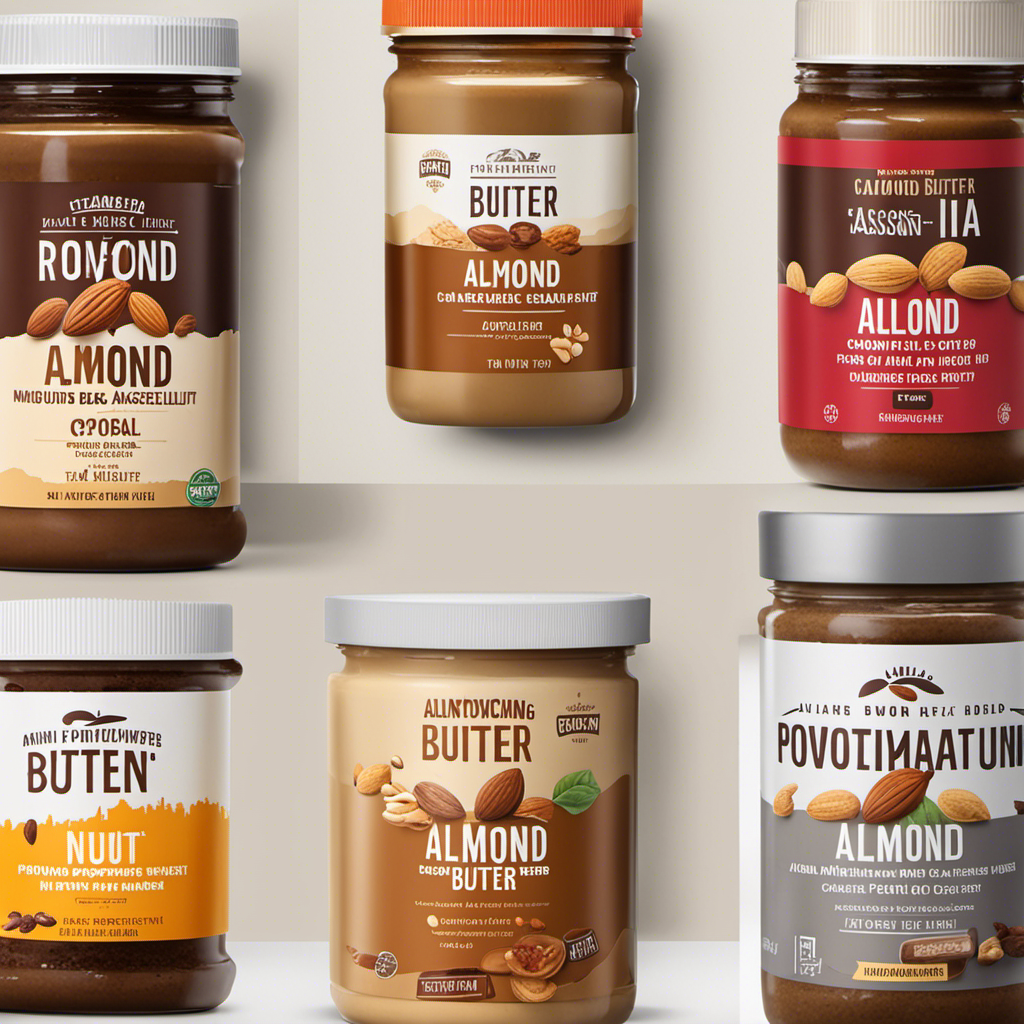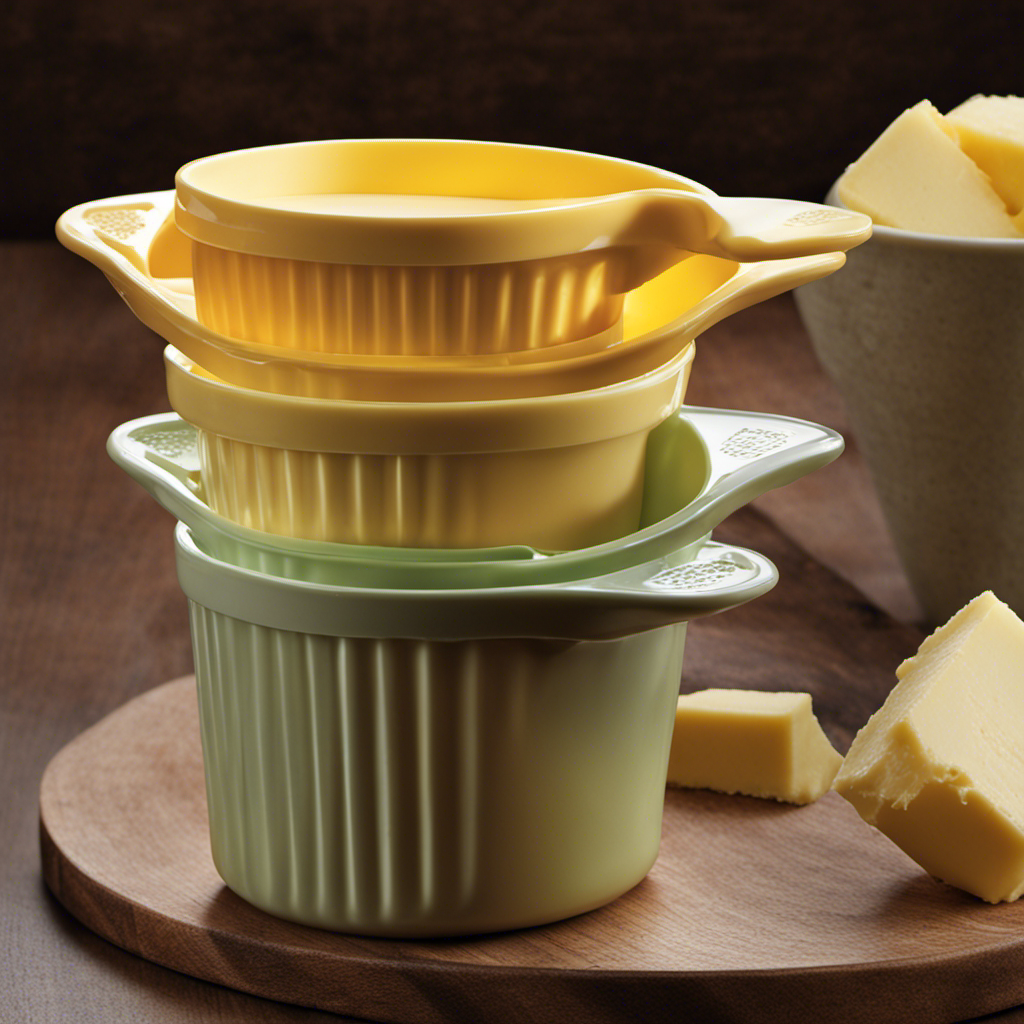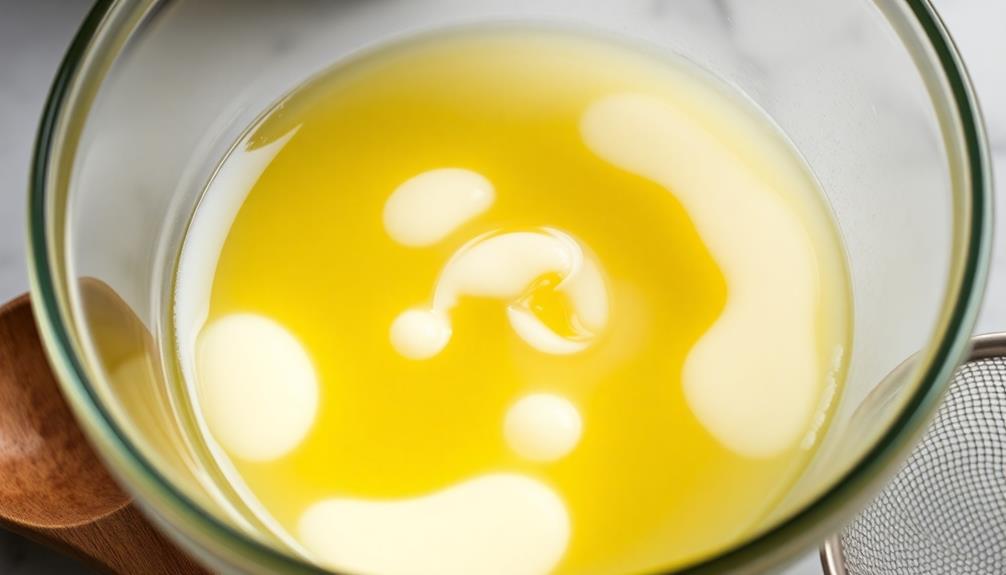As someone who studies food science, I’ve consistently been intrigued by the health advantages various foods offer. Specifically regarding nut butters, a common inquiry is: which type offers the highest protein content?
In this article, I’ll guide you through a journey of flavors and protein power. From the classic peanut butter to the rich and creamy almond butter, we’ll explore the protein content of various nut butters.
So grab a spoon and get ready to discover which nut butter reigns supreme in the protein department.
Key Takeaways
- Almond butter provides approximately 7 grams of protein per serving, making it a high protein option.
- Peanut butter contains more protein compared to almond butter, making it a good choice for those looking for a higher protein content.
- Alternative nut butters like cashew butter, sunflower seed butter, and coconut butter also have protein content, with cashew butter being surprisingly high in protein.
- Sunflower seed butter and sesame seed butter (tahini) are plant-based protein alternatives, but have lower protein content compared to almond and cashew butter.
Almond Butter: a Protein Powerhouse
Almond butter’s high protein content makes it a great choice for those looking to increase their protein intake. With approximately 7 grams of protein per serving, almond butter is a protein powerhouse.
Not only does it provide a good amount of protein, but it also offers several other benefits. Almond butter is rich in healthy fats, fiber, and essential vitamins and minerals. It can be a versatile ingredient in various recipes, from smoothies and oatmeal to baked goods and savory dishes.
Incorporating almond butter into your diet can help support muscle growth and repair, boost satiety, and provide sustained energy throughout the day.
Transitioning into the subsequent section about peanut butter, let’s explore another classic protein-packed choice.
Peanut Butter: the Classic Protein-Packed Choice
When it comes to choosing a nut butter, the almond vs peanut debate often comes up. In this discussion, we will compare the nutritional profiles of almond butter and peanut butter, examining their protein content and other key factors.
Additionally, we will explore the pros and cons of alternative nut butters, providing a comprehensive view of the different options available.
Let’s dive in and discover the facts about these popular spreads to help you make an informed decision for your dietary needs.
Almond Vs Peanut: Nutritional Comparison
If you’re comparing almond and peanut butter, you’ll notice that peanut butter generally has more protein. However, it’s important to consider other factors when deciding which nut butter to choose.
In terms of taste, almond butter has a slightly sweeter and nuttier flavor compared to the more savory taste of peanut butter.
When it comes to environmental impact, almonds require more water to grow compared to peanuts. Additionally, almond orchards contribute to the decline of bee populations due to their heavy reliance on pollination. On the other hand, peanuts are a more sustainable choice as they require less water and have a lower carbon footprint.
Ultimately, the decision between almond and peanut butter should be based on personal preferences and dietary needs, taking into account factors such as taste and environmental impact.
Alternative Nut Butters: Pros and Cons
Peanut butter, on the other hand, tends to be more widely available and affordable compared to other nut butter alternatives. As a food scientist, I want to present a balanced view of different nut butters, highlighting their protein content without promoting one over the other.
Here are the pros and cons of using alternative nut butters for protein:
-
Almond butter: Rich in protein and healthy fats, but can be more expensive than peanut butter.
-
Cashew butter: Creamy and delicious, with a surprising amount of protein. Great for those looking for a nut butter alternative.
-
Sunflower seed butter: Nut-free and high in protein, but may have a slightly different taste and texture compared to traditional nut butters.
-
Coconut butter: Provides a unique flavor and texture, but has a lower protein content compared to other nut butters.
Now, let’s dive into the surprising protein content of cashew butter.
Cashew Butter: a Surprisingly Rich Source of Protein
When it comes to comparing the protein content of cashew butter and almond butter, it’s important to consider the nutritional value of both options.
While almonds are often touted as a great source of protein, cashews actually contain a surprising amount as well.
In addition to their protein content, cashew butter also offers a range of health benefits, such as being rich in heart-healthy fats and essential vitamins and minerals.
To make an informed decision about which nut butter is right for you, it’s helpful to compare their protein content and consider the overall nutritional profile of each option.
Cashew Vs. Almond Protein
You’ll find that cashew butter has slightly more protein than almond butter. Here are four reasons why adding nut butters, like cashew and almond butter, to your diet is beneficial:
-
Protein Powerhouse: Cashew butter and almond butter are both excellent sources of plant-based protein. Protein is essential for building and repairing tissues, supporting a healthy immune system, and maintaining muscle mass.
-
Heart-Healthy Fats: Both cashew butter and almond butter are high in heart-healthy monounsaturated fats. These fats can help lower bad cholesterol levels and reduce the risk of heart disease.
-
Nutrient Boost: Nut butters are packed with essential nutrients like vitamin E, magnesium, and potassium. These nutrients play a vital role in promoting overall health and wellbeing.
-
Versatile and Delicious: Cashew and almond butter can be used in a variety of ways, from spreading it on toast to adding it to smoothies or using it as a dip for fruits and vegetables. They offer a tasty and nutritious addition to any meal or snack.
When it comes to choosing between cashew and almond butter, both are nutritious options. Ultimately, the choice depends on personal preference and dietary needs.
Health Benefits of Cashew Butter
Now that we have compared the protein content of cashew butter and almond butter, let’s focus on the health benefits of cashew butter.
Cashew butter is not only delicious but also provides several nutritional benefits. Like other nut butters, cashew butter is a good source of healthy fats, protein, and fiber. It also contains essential vitamins and minerals, such as vitamin E, magnesium, and zinc.
The high protein content in cashew butter can help support muscle growth and repair, making it a great option for individuals who follow a plant-based or vegetarian diet. Additionally, the healthy fats in cashew butter can help promote heart health and reduce the risk of chronic diseases.
Remember to consume cashew butter in moderation as part of a balanced diet to fully enjoy its health benefits.
Protein Content Comparison
Let’s take a look at how the protein content compares between cashew butter and almond butter. When it comes to protein, here’s what you need to know:
-
Cashew butter: Cashew butter is a good source of protein, containing around 5 grams per 2 tablespoons. This makes it a great option for those looking to increase their protein intake.
-
Almond butter: Almond butter is slightly higher in protein compared to cashew butter, with approximately 7 grams per 2 tablespoons. This makes it an even better choice for those looking for a protein boost.
-
Sunflower butter: Sunflower butter has a lower protein content compared to both almond and cashew butter, with only around 3 grams per 2 tablespoons. While it still provides some protein, it may not be the best option if you’re solely looking for a high-protein spread.
-
Sesame butter: Similar to sunflower butter, sesame butter has a lower protein content, with approximately 4 grams per 2 tablespoons. While it does provide some protein, it may not be the top choice if protein is your main concern.
Hazelnut Butter: a Delicious Way to Boost Your Protein Intake
If you’re looking to boost your protein intake, hazelnut butter is a delicious option. As a food scientist, I can assure you that hazelnut butter is a nutritious choice for a post-workout snack.
Not only does it provide a rich and creamy taste, but it also offers several nutritional benefits. Hazelnut butter is a good source of protein, containing around 4 grams per tablespoon. It also provides essential vitamins and minerals, such as vitamin E and magnesium, which are important for muscle recovery and overall health. Additionally, hazelnut butter is packed with healthy fats, fiber, and antioxidants, making it a great addition to a balanced diet.
Now, let’s explore another nut butter option: pistachio butter, a lesser-known but protein-rich choice.
Pistachio Butter: a Lesser-Known but Protein-Rich Option
Looking for a lesser-known but protein-rich option? Give pistachio butter a try! Here are four reasons why pistachio butter can be a beneficial addition to your diet:
-
High Protein Content: Pistachio butter contains a good amount of protein, making it a suitable option for those looking to increase their protein intake.
-
Nutritional Benefits: Pistachios are packed with essential nutrients like vitamins, minerals, and antioxidants. Incorporating pistachio butter into your diet can provide these beneficial nutrients.
-
Heart-Healthy Fats: Pistachios are rich in monounsaturated fats, which can promote heart health and reduce the risk of cardiovascular diseases when consumed as part of a balanced diet.
-
Versatility and Homemade Option: You can easily make pistachio butter at home by blending roasted pistachios until smooth. This allows you to control the ingredients and customize the flavor to your liking.
Remember to consume pistachio butter in moderation and as part of a well-balanced diet to reap its benefits.
Walnut Butter: a Nutritious Nut Butter With a Good Protein Content
Try incorporating walnut butter into your diet for a nutritious option that provides a good amount of protein. Walnut butter is not only delicious, but it also offers several health benefits. It is a good source of protein, which is essential for building and repairing tissues in the body. Walnut butter also contains healthy fats, fiber, vitamins, and minerals. Here is a table comparing the protein content of different nut butters, including walnut butter:
| Nut Butter | Protein Content per 2 tablespoons |
|---|---|
| Almond Butter | 6 grams |
| Peanut Butter | 8 grams |
| Walnut Butter | 5 grams |
| Cashew Butter | 5 grams |
To incorporate walnut butter into your diet, you can spread it on toast, add it to smoothies, or use it as a dip for fruits and vegetables. Remember to choose natural and unsweetened varieties to avoid added sugars and unhealthy fats. Enjoy the protein-packed goodness of walnut butter while reaping its many health benefits.
Macadamia Butter: a Creamy and Protein-Dense Choice
Macadamia butter is a creamy choice that is packed with protein. Here are four reasons why it’s worth adding to your pantry:
-
Nutritional Powerhouse: Macadamia butter is not only delicious, but it also boasts an impressive nutritional profile. It contains essential vitamins and minerals like vitamin B6, thiamin, magnesium, and manganese, which support overall health and well-being.
-
Cashew Butter Health Benefits: While almond butter is often touted as a popular choice, macadamia butter rivals its nutritional benefits. Macadamia butter contains more protein and healthy fats, making it a great option for those looking to boost their protein intake.
-
Superior Protein Content: Compared to almond butter, macadamia butter has a higher protein content per serving. This makes it an excellent choice for athletes, vegans, or anyone looking to increase their protein intake.
-
Creamy and Delicious: Macadamia butter offers a rich and creamy texture that can enhance the flavor of your favorite snacks. Whether you spread it on toast, blend it into smoothies, or use it as a dip for fruits and vegetables, macadamia butter adds a delightful taste to any dish.
Transition: If you’re looking for another plant-based protein alternative, sunflower seed butter is an excellent option to explore.
Sunflower Seed Butter: a Plant-Based Protein Alternative
If you’re searching for a new way to add plant-based protein to your diet, sunflower seed butter is a fantastic choice. Sunflower seed butter offers numerous benefits as a source of protein and can be incorporated into a variety of recipes.
Sunflower seeds are rich in essential amino acids, making them a complete protein source. They also provide a good amount of healthy fats, vitamins, and minerals.
Sunflower seed butter can be used as a spread on toast, added to smoothies, or used as a dip for fruits and vegetables. It can also be used in baking to add a nutty flavor and boost the protein content of baked goods. Just remember to check the label for added sugars and oils.
With its versatility and nutritional benefits, sunflower seed butter is a great addition to any diet.
Sesame Seed Butter (Tahini): a Unique Nut Butter With a Good Protein Profile
Sesame seed butter, also known as tahini, is a creamy and versatile spread that offers a unique flavor and a good amount of protein. Here are four reasons why sesame seed butter is a great choice for your diet:
-
High Protein Content: Sesame seed butter is a rich source of plant-based protein, making it an excellent option for vegetarians and vegans looking to meet their protein needs.
-
Nutritional Profile: Sesame seed butter is also packed with essential nutrients such as iron, calcium, and healthy fats. These nutrients play a crucial role in supporting overall health and well-being.
-
Heart-Healthy Benefits: Studies have shown that sesame seed butter may help reduce the risk of heart disease by improving cholesterol levels and reducing inflammation.
-
Versatility in Cooking: Sesame seed butter can be used in a variety of recipes, from sauces and dressings to baked goods and smoothies. It adds a distinct nutty flavor and creamy texture to any dish.
When it comes to nutritional comparison, sesame seed butter offers similar protein content compared to other nut butters like almond or peanut butter. However, it is lower in carbohydrates and higher in healthy fats.
Incorporating sesame seed butter into your diet can provide a delicious and nutritious boost to your meals.
Frequently Asked Questions
Can Nut Butter Be a Good Source of Protein for Vegetarians and Vegans?
Nut butter can be a great source of protein for vegetarians and vegans. It serves as an alternative protein source for athletes and helps meet daily protein requirements.
How Does the Protein Content of Almond Butter Compare to Other Nut Butters?
The protein content in almond butter compared to other nut butters varies depending on the processing methods used. Different methods can impact protein levels, making it important to consider how the nut butter is made.
Are There Any Potential Allergens in Nut Butters That Could Affect Protein Absorption?
There may be potential allergens in nut butters that could affect protein absorption. It’s important to consider individual allergies and sensitivities. Nut butter can be a helpful addition to a weight loss plan due to its protein content.
Can Consuming Nut Butter Help With Muscle Recovery After Exercise?
Consuming nut butter as a post-workout snack can aid in muscle recovery. Its protein content provides essential amino acids for repairing and building muscles. It’s a tasty and convenient option for fueling your body after exercise.
Is It Possible to Get Enough Protein Solely From Nut Butter, or Should It Be Combined With Other Protein Sources?
Nut butter can be a convenient source of protein, but it’s important to consider it as part of a balanced diet. Combining it with other protein sources ensures adequate intake and supports muscle growth.
Conclusion
In conclusion, when it comes to nut butters, there are a variety of options that can provide a good source of protein.
Almond butter stands out as a true protein powerhouse, while peanut butter remains a classic choice for protein-packed goodness.
Cashew butter surprises with its rich protein content, and hazelnut butter offers a delicious way to boost protein intake.
Pistachio butter is a lesser-known but protein-rich option, while walnut butter provides nutritious protein content.
Macadamia butter is a creamy and protein-dense choice, and sunflower seed butter serves as a plant-based protein alternative.
Finally, sesame seed butter, or Tahini, offers a unique nut butter with a good protein profile.
As the saying goes, ‘Variety is the spice of life,’ and with so many protein-rich nut butter options available, you can add excitement and nutrition to your diet.









